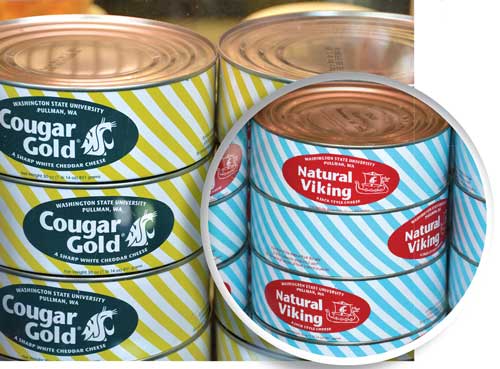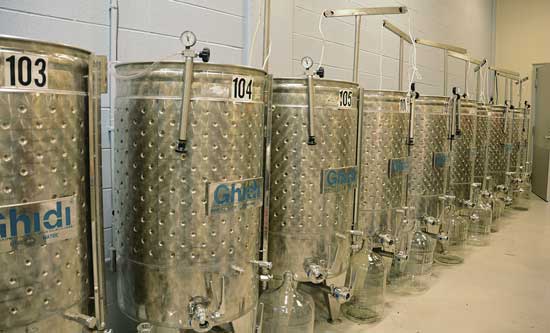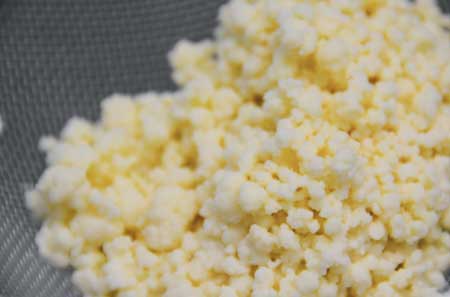The Good, the Bad, and the Ugly: A Fermentation Saga
INSIDE ACADEMIA
 The goal of all living organisms is to survive. To prolong their existence, humans, plants, and animals make energy, and so do microbes. Some microorganisms are considered beneficial to other living organisms while others are not. In either scenario, “their goal is really to grow and reproduce,” says Gülhan Ünlü, an associate professor at the University of Idaho. To do that, they must generate enough energy for survival, but how and at what cost? “In food microbiology, we have the Good, the Bad, and the Ugly—just like the movie,” Ünlü says. The Ugly are microorganisms that cause food spoilage. The Bad are foodborne pathogens that can cause illness. And the Good are the bacteria, yeasts, and molds that are essential to the existence of certain foods. Ünlü is one of the faculty members at the bi-state School of Food Science of the University of Idaho and Washington State University, where a new food science option has emerged that prepares students to nurture and exploit the benefits of the Good: fermentation science.
The goal of all living organisms is to survive. To prolong their existence, humans, plants, and animals make energy, and so do microbes. Some microorganisms are considered beneficial to other living organisms while others are not. In either scenario, “their goal is really to grow and reproduce,” says Gülhan Ünlü, an associate professor at the University of Idaho. To do that, they must generate enough energy for survival, but how and at what cost? “In food microbiology, we have the Good, the Bad, and the Ugly—just like the movie,” Ünlü says. The Ugly are microorganisms that cause food spoilage. The Bad are foodborne pathogens that can cause illness. And the Good are the bacteria, yeasts, and molds that are essential to the existence of certain foods. Ünlü is one of the faculty members at the bi-state School of Food Science of the University of Idaho and Washington State University, where a new food science option has emerged that prepares students to nurture and exploit the benefits of the Good: fermentation science.
 Fermentation is a natural metabolic process in which microorganisms convert carbohydrates into either alcohol or acid. Through these conversions, certain microorganisms play a role in two of the most important functions of food processing: food preservation and food safety. Fermentative bacteria, yeasts, and molds (the Good) preserve foods by producing metabolites such as lactic acid, acetic acid, propionic acid, ethanol, and bacteriocins that suppress the growth of spoilage microorganisms (the Ugly) and pathogenic microorganisms (the Bad) that are naturally present in foods. “One of the things about fermented foods that I’ve always enjoyed is that a lot of fermented foods are actually safe for consumption because there is an antagonism … an ongoing microbial war,” says Charles Edwards, a food science professor at Washington State University. “For instance, there is not one pathogen that will grow in wine—not one.” Fermentative microorganisms also enhance the organoleptic properties of foods. “I like to define food fermentations as taking a raw material and converting that raw material to a desirable product in which flavor, aroma, texture, and appearance of that raw material is drastically changed,” Ünlü says.
Fermentation is a natural metabolic process in which microorganisms convert carbohydrates into either alcohol or acid. Through these conversions, certain microorganisms play a role in two of the most important functions of food processing: food preservation and food safety. Fermentative bacteria, yeasts, and molds (the Good) preserve foods by producing metabolites such as lactic acid, acetic acid, propionic acid, ethanol, and bacteriocins that suppress the growth of spoilage microorganisms (the Ugly) and pathogenic microorganisms (the Bad) that are naturally present in foods. “One of the things about fermented foods that I’ve always enjoyed is that a lot of fermented foods are actually safe for consumption because there is an antagonism … an ongoing microbial war,” says Charles Edwards, a food science professor at Washington State University. “For instance, there is not one pathogen that will grow in wine—not one.” Fermentative microorganisms also enhance the organoleptic properties of foods. “I like to define food fermentations as taking a raw material and converting that raw material to a desirable product in which flavor, aroma, texture, and appearance of that raw material is drastically changed,” Ünlü says.
 “Our major concern most of the time is ensuring microbial food safety. We have various technologies … to ensure food safety. As a result we process our foods and our goal is to inactivate these microorganisms so that our food is safe. Regarding spoilage microbes, even if they survive, it’s okay because they [typically] don’t make us sick,” Ünlü adds. “The goal of all three microorganisms that we deal with in food microbiology—good, bad, and ugly—is to have a life just like we do. As a result, they can be dangerous for us, they can spoil our food, or they can help us generate wonderful food products that we all enjoy. What would we do without cheese, yogurt, fermented vegetables, bread, beer and wine, and my favorite, chocolate? Life would be very boring without them.”
“Our major concern most of the time is ensuring microbial food safety. We have various technologies … to ensure food safety. As a result we process our foods and our goal is to inactivate these microorganisms so that our food is safe. Regarding spoilage microbes, even if they survive, it’s okay because they [typically] don’t make us sick,” Ünlü adds. “The goal of all three microorganisms that we deal with in food microbiology—good, bad, and ugly—is to have a life just like we do. As a result, they can be dangerous for us, they can spoil our food, or they can help us generate wonderful food products that we all enjoy. What would we do without cheese, yogurt, fermented vegetables, bread, beer and wine, and my favorite, chocolate? Life would be very boring without them.”
For all foodborne microorganisms, certain factors either promote their growth or inhibit it. Temperature, water activity, oxygen, nutrients, and pH value (level of acidity or alkalinity) are major factors that affect microbial growth. Fermentative microbes preserve foods and make them safe for consumption by increasing either the acid content or alcohol content of foods or reducing the water activity of foods. Also aiding the fermentation process is a food’s concentration or level of salt or sugar, both of which help retard microbial growth. “These factors affect [microorganisms] differently. For example, most bacteria require a lot of water for growth. As a result, when we have fresh produce with pH values close to neutral, we expect bacterial growth,” Ünlü explains. “Yeasts and molds are two groups of microorganisms that can tolerate more acidic conditions and more salt and more sugar than bacteria. So when your salad dressings, jams, and fruits go bad, it’s mostly because of yeasts and molds. But with other foods that have a pH closer to neutral, which is about 7, most of the time they go bad from bacterial growth.” Desirable fermentations, in which specific food products are the result, require manipulation of these factors to ensure that the right fermentative microorganisms grow in particular substrates.
The Fermentative Protagonists
Some of the most important microbes for producing desirable fermentations are lactic acid bacteria. As their name implies, lactic acid bacteria metabolize carbohydrates into lactic acid and other byproducts: Homofermentative lactic acid bacteria produce only lactic acid, and the byproducts of heterofermentative lactic acid bacteria are lactic acid, acetic acid, ethyl alcohol, and carbon dioxide. They also tolerate high salt concentrations. “In the presence of organic acids such as lactic acid, acetic acid, propionic acid, and some other acids, the pH of the food goes down. Foodborne pathogens have a hard time growing under those conditions,” Ünlü says. Lactic acid bacteria “lower the pH of a product but also produce some very unique flavors,” Edwards adds. Some of the foods produced through lactic acid bacteria fermentation are sourdough bread, chocolate, pickles, sauerkraut, sausage, sour cream, and yogurt. But not all fermentation by lactic acid bacteria is desirable: “In certain situations, such as vegetable fermentations, such as making sauerkraut or pickles, you want to have [lactic acid] bacteria active, fermenting the sugars into lactic acid,” Edwards says. “But in other situations, they can cause spoilage because they cause off flavors and off odors, and then all of a sudden, the sauerkraut doesn’t smell right and doesn’t taste right. Or in breweries and cideries and wineries, you can get the same types of bacteria growing and that creates all sorts of off flavors and off aromas.”
 While only a few bacteria species can tolerate acidic environments, most yeasts are tolerant of lower pH values (3.5–5) and higher concentrations of salt and sugar. Thus, foodborne yeasts are naturally present in low-acid foods but can be involved in the fermentation of both acidic and nonacidic foods. Perhaps the most beneficial yeasts for fermentation are members of the genus Saccharomyces, which metabolize sugar into ethanol and carbon dioxide. The ethanol kills most of the other microbes in products of Saccharomyces fermentation. These microorganisms are involved in the production of beer, wine, bourbon, whiskey, vodka, and other distilled spirits. “Saccharomyces is a critical microorganism; if we didn’t have that, we wouldn’t have all these fermented beverages that we enjoy,” Edwards says. Saccharomyces are also essential in the production of bread.
While only a few bacteria species can tolerate acidic environments, most yeasts are tolerant of lower pH values (3.5–5) and higher concentrations of salt and sugar. Thus, foodborne yeasts are naturally present in low-acid foods but can be involved in the fermentation of both acidic and nonacidic foods. Perhaps the most beneficial yeasts for fermentation are members of the genus Saccharomyces, which metabolize sugar into ethanol and carbon dioxide. The ethanol kills most of the other microbes in products of Saccharomyces fermentation. These microorganisms are involved in the production of beer, wine, bourbon, whiskey, vodka, and other distilled spirits. “Saccharomyces is a critical microorganism; if we didn’t have that, we wouldn’t have all these fermented beverages that we enjoy,” Edwards says. Saccharomyces are also essential in the production of bread.
Similar to yeasts, molds are highly tolerant of low pH and high concentrations of salt and sugar but have lower requirement for water activity. Both yeasts and molds are fungi, but unlike fermentative yeasts and bacteria, foods fermented by molds are less abundant. Molds generally play a greater role in food spoilage because they can colonize and grow on most types of foods, tolerating environments with pH values of 2–8.5. But certain molds of the genera Aspergillus and Penicillum extend shelf life and improve the color, flavor, and texture of dairy, plant, and meat products. In many cases, molds are responsible for secondary fermentations that occur after primary fermentations by bacteria or yeasts. “Molds are usually very important in Asian fermented foods. But usually when we use a mold culture for fermentation purposes, we tend to have bacteria and yeasts in the mixture as well,” Ünlü says. Camembert and gorgonzola cheeses, tempeh, miso, soy sauce, salami, and European sausages are examples of mold-fermented foods.
“Only rarely does a fermented food go bad from a safety point of view. It depends on the food, of course, and it depends on how it was actually processed,” Edwards says. “For instance, if you are trying to make sauerkraut and you don’t add any salt, well you have an anaerobic environment with a high pH vegetable. That is a potential recipe for absolute disaster. The salt will help inhibit some of the pathogens. What happens more often with fermented foods—wines, beers, ciders, and so on—is that you get something growing in those foodstuffs that produces off flavors, [and] off aromas. The food is still edible, but it doesn’t taste really good.” For example, Edwards and his students are studying Brettanomyces, a yeast that causes wine to spoil. “Brettanomyces causes off flavors and off odors in red wine. It’s one of those funny organisms that [with] little amounts of it, some winemakers like some of the sensory characteristics,” Edwards says. “Some of the prominent Bordeaux [wines] from France have a significant level of Brettanomyces in them. So those sensory characteristics—at least to the folks who make Bordeaux—are appreciated. They like that; they expect that. Here in the states, I think that there’s more of a resistance to those types of flavors.”
The Producers
Besides food preservation and food safety, the bacteria, yeasts, and molds involved in desirable food fermentations perform other functions. They increase the amount of raw materials that can be used as food by removing antinutritional or toxic factors; enhance the bioavailability of nutrients by altering the chemical constituents of raw materials; transform or remove the allergenic components of certain foods, rendering such foods consumable by people with food allergies or intolerances; and provide food security, income, and employment for people around the world—in particular, the residents of Washington and Idaho. “We have an incredible diversity of agriculture up here, and much of it revolves around fermentation of some sort,” Edwards points out. There are more than 850 wineries, 250 breweries, and 110 distilleries in Washington, and cider production is a robust growing industry. “In the state of Washington, wine science or wine technology is big. … It is the same for the state of Idaho. As a matter of fact, we have had quite a few students who have opened their own wineries,” Ünlü says. “So we figured out quite some time ago that there will be an increasing need for fermentation scientists in the Pacific Northwest.”
 The fermentation science program at Washington State University (and eventually the University of Idaho) is fairly unique. “What’s different about our program is that it’s not just a brewing program; it’s not just a wine program. It’s an industrial microbiology, biochemical engineering, fermented foods program,” explains Barbara Rasco, a professor at Washington State University. “Our goal is to have students learn the basic skills associated with bacterial, fungal, and enzyme fermentation and get the other basic science and engineering principles they need so that they can work in any aspect of the industry.” For this reason, individuals who pursue a fermentation science degree in Washington and Idaho obtain a more comprehensive foundation. “There’s a lot of [schools] that have brewing programs or they have wine programs. Our feeling was that wasn’t a broad enough foundation,” Rasco says. Because of the expertise of the faculty at Washington State University and University of Idaho, “students get exposure to all different products: bread and cereals, malting, beer, wine, cider, vegetable fermentations, and some fermented Asian products (things like fish sauce),” Rasco says.
The fermentation science program at Washington State University (and eventually the University of Idaho) is fairly unique. “What’s different about our program is that it’s not just a brewing program; it’s not just a wine program. It’s an industrial microbiology, biochemical engineering, fermented foods program,” explains Barbara Rasco, a professor at Washington State University. “Our goal is to have students learn the basic skills associated with bacterial, fungal, and enzyme fermentation and get the other basic science and engineering principles they need so that they can work in any aspect of the industry.” For this reason, individuals who pursue a fermentation science degree in Washington and Idaho obtain a more comprehensive foundation. “There’s a lot of [schools] that have brewing programs or they have wine programs. Our feeling was that wasn’t a broad enough foundation,” Rasco says. Because of the expertise of the faculty at Washington State University and University of Idaho, “students get exposure to all different products: bread and cereals, malting, beer, wine, cider, vegetable fermentations, and some fermented Asian products (things like fish sauce),” Rasco says.
--- PAGE BREAK ---
 For the fermentation science option, Ünlü teaches food microbiology courses; Edwards teaches food chemistry and wine microbiology courses; and Brennan Smith, an assistant professor at the University of Idaho, teaches cereal chemistry and processing. Because barley, corn, wheat, and sorghum are all used to make many fermented foods, Smith’s course is key to bread-making, beer-making, and distilling. “My expertise is the chemistries of cereal grains and the things leading up to the fermentations. I teach a junior-level cereal grains chemistry, technology, and processing course. So my role in the program is kind of laying the foundation for the students to learn about fermentations,” Smith explains. “[For] a lot of the fermentations, … it’s hard to ignore the cereal grains and their chemistries. I [teach students about] the ... growing conditions, how that influences the chemistries and anatomical features of the grains, and how those chemistries and anatomical features of the cereal grains influence processing and utilization.”
For the fermentation science option, Ünlü teaches food microbiology courses; Edwards teaches food chemistry and wine microbiology courses; and Brennan Smith, an assistant professor at the University of Idaho, teaches cereal chemistry and processing. Because barley, corn, wheat, and sorghum are all used to make many fermented foods, Smith’s course is key to bread-making, beer-making, and distilling. “My expertise is the chemistries of cereal grains and the things leading up to the fermentations. I teach a junior-level cereal grains chemistry, technology, and processing course. So my role in the program is kind of laying the foundation for the students to learn about fermentations,” Smith explains. “[For] a lot of the fermentations, … it’s hard to ignore the cereal grains and their chemistries. I [teach students about] the ... growing conditions, how that influences the chemistries and anatomical features of the grains, and how those chemistries and anatomical features of the cereal grains influence processing and utilization.”
The fermentation science program is part of a partnership between the food science departments at Washington State University and University of Idaho that began informally a while ago. “We’ve been teaching classes together, starting in the late 1990s, because of the facilities that each campus had,” says Rasco, who is also the director of the School of Food Science of the two universities. “What we found is that if we could take advantage of the opportunities and resources both universities had, we would have a better and stronger program. The two programs formally merged in 2010, but actually we were working as a fully integrated unit in about 2008. It works pretty well because we’ve got people, particularly the faculty, buying into it.”
Humans have been fermenting foods for thousands of years, and for most of that time, fermentation and the microorganisms that perform it were a mystery. At the School of Food Science jointly administered by Washington State University and University of Idaho, faculty members provide students with the knowledge and skills necessary to continue this ancient form of preservation and food safety for years to come, ensuring that in the food fight between the Good, the Bad, and the Ugly, the Good will prevail and continue to provide a cornucopia of delicious foods.
 Kefir: The Yogurt of the Future?
Kefir: The Yogurt of the Future?
University of Idaho associate professor Gülhan Ünlü remembers a time in the 1970s and 1980s when yogurt was not common in supermarkets, so people made it themselves at home. Now supermarket shelves are packed with a variety of brands, flavors, and types of yogurt. Ünlü believes that kefir will go through the same transition. “I see kefir as 21st century yogurt,” she pronounces. Kefir is a fermented milk-based drink made by the actions of a legion of symbiotic microorganisms. “Kefir is a very complex probiotic. There are over 30 different species of organisms in kefir, including lactic acid bacteria and yeast,” she explains. These microorganisms are encased in a matrix of milk proteins and polysaccharides called kefir grains, which resemble small clumps of cauliflower or popcorn. Cow’s milk is most commonly used to make kefir, but the beverage can be made by inoculating any type of milk with kefir grains. This can be done simply enough in home kitchens but is impractical for commercial kefir products. Commercial kefir products are thus made with a starter culture instead of actual kefir grains, which means commercial kefir products tend not to have the same properties (fewer probiotics, diminished health benefits, etc.) as traditional kefir.
In an effort to remedy this issue, Ünlü and her laboratory staff are working to create shelf- stable kefir grains. “We want to make sure that each and every one of them is preserved. To do that, we are working with … cryoprotectants,” she says. The idea is that instead of buying commercial kefir products, consumers can purchase shelf-stable kefir grains and make their own probiotic dairy beverages. Ünlü and her laboratory team also conduct ongoing research on the health benefits that kefir may possess. “Right now I am working with kefir as a functional food in my laboratory,” she says. One of the projects involves determining what effects kefir may have on diabetes and cholesterol markers.
Toni Tarver is senior writer/editor of Food Technology magazine ([email protected]).
